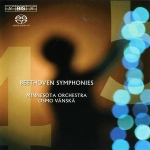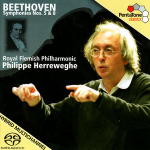Home » Jazz Articles » Bailey's Bundles » The Beethoven Symphony Series 2: Two Fifth Symphonies - ...
The Beethoven Symphony Series 2: Two Fifth Symphonies - Vanska and Herreweghe
This is the first article addressing the Beethoven sympnonies individually. For an introduction to the composer's symphony cycle, see The Beethoven Symphony Series 1: The Nine Symphonies
Ludwig van Beethoven's Fifth Symphony, Opus 67, is one of the most recognizable pieces of classical music. Its distinctive four-note motif, struck twice to introduce the piece, is immediately identifiable as a hallmark of Western, if not world, civilization.
The Fifth Symphony was difficult for Beethoven to complete. The first sketches of the piece were made in 1804, following his finishing touches on the Third Symphony. Between 1804 and 1808, Beethoven was repeatedly distracted from his work on the Fifth to compose other pieces, including the first version of his opera Fidelio, the Appassionata piano sonata, the Violin Concerto, the Fourth Piano Concerto, and the Fourth Symphony. Completion of the Fifth Symphony took place in late 1807 or early 1808 and was conducted contemporaneously with completion of the Sixth Symphony.
The Fifth Symphony premiered on December 22, 1808 at a at the Theater an der Wien in Vienna. The concert consisted entirely of Beethoven premieres directed by the composer himself. The performance took more than four hours and included in addition to the Fifth Symphony, the Sixth Symphony, sections from the C Major Mass, the Fourth Piano Concerto, and the Choral Fantasy.
Beethoven has never been out vogue or the concert hall. Recordings of the complete nine symphonies abound, and the Fifth and Ninth Symphonies abound in particular. Two notable orchestras and conductors are currently working their respective ways through Beethoven's symphonic canon: Osmo Vanska and the Minnesota Orchestra (in the first American cycle in decades) on BIS and Philippe Herreweghe and the Royal Flemish Philharmonic on Pentatone.
These two conductors and orchestras approach Beethoven from two unique and well-established directions, with two equally unique and fresh interpretations. Add to this the hybrid SACD capability and these recordings win on all fronts. The nice thing about recording Beethoven symphony cycles is that the listener is guaranteed nine superb pieces of music.
 Minnesota Orchestra, Osmo Vanska
Minnesota Orchestra, Osmo Vanska Ludwig van Beethoven: Symphonies 4 and 5
BIS Records
2005
The United States has provided several notable Beethoven symphony cycles that include Arturo Toscanini with the NBC Symphony Orchestra, George Szell with the Cleveland Symphony Orchestra, Bruno Walter with the Columbia Symphony Orchestra, and Sir Georg Solti with the Chicago Symphony Orchestra. All of these sets are time honored and continue to be well thought of.
These performances are characterized by an expansive portrait sound comparable to a large colorful landscape. Performance and recording methods render these symphonies as wall-of-sound, two dimension large canvas scale. Osmo Vanska's inaugural recording with the Minnesota Orchestra on BIS records is no exception to this rule. If anything, Vanska's canvas is super-sized, providing a panoramic view of Beethoven in all his splendor. "Symphony No. 5" (coupled with "Symphony No.4" here) is as robust as it is plush.
Vanska opts for conservative tempi with a broad and deep sonority. The BIS engineering places the entire orchestra in the back, with the instruments using equal ground in the sound window. The percussion is equal to the strings and the strings are equal to the brass. Vanska makes no historical performance claims outside of his desire to stay faithful to the original score. As the history of recording has shown, this can mean a lot of things.
Vanska's Fifth (coupled here with the Fourth Symphony) is deliberately and thoughtfully paced. The transition from the third to fourth movements is seamless and powerful, exuding all of the majesty intended by the composer. Such conducting consideration typically leads to a darker, more rich interpretation, one that shines its light from the Romantic side of Wagner rather than the Classical side of Haydn. The result is a full-bodied American performance captured in living color by the crack BIS engineers. This is warm surround-sound Beethoven.
 Royal Flemish Philharmonic, Philippe Herreweghe
Royal Flemish Philharmonic, Philippe Herreweghe Ludwig van Beethoven: Symphonies Nos. 5 and 8
Pentatone Records
2007
Philippe Herreweghe could not have approached his Fifth Symphony any more differently. Herreweghe is best known for his period instrument recordings of the Baroque repertoire with his Colligum Vocale. Like Nikolaus Harnoncourt before him, Herreweghe takes his period instrument experience and applies it to the modern orchestra, in this case with dazzling effect.
Herreweghe takes allegro con brio seriously, opening at a fast pace. Sonically this is three dimensional Beethoven the listener can walk around in. Where Vanska's Fifth is a beautiful painting, Herreweghe's is an interactive landscape where tones fly around the listener as he or she is walking through. Herreweghe's approach and attack are fresh and clean with little of the romantic excess usually reserved for this piece in the 20th century. The engineering ensures discreet separation between insturments and instrument groups.
This is Beethoven at a trot. While thoughtfully considered, Herreweghe throws this masterpiece off with a fearlessness that never breaks down. The symphony makes sense. While not a high wire act, Herreweghe's Fifth is nevertheless a bracing experience for the listener, who will hear the piece and wonder when it will fall apart, but it never does and in fact is executed perfectly. The 5.1.1 Surround Sound is stunning. One might expect Herreweghe's Ninth to require a new Holy Day of Obligation.
Tracks and Personnel
Vanska: Beethoven Symphonies 4 and 5
Tracks: Symphony No. 4, Opus 60: 1. Adagio - Allegro vivace, 2. Adagio, 3. Allegro - Vivace, 4. Allegro ma non troppo; Symphony No. 5, Opus 67: 1. Allegro con brio; 2. Andante con moto; 3. Scherzo. Allegro; 4. Allegro.
Personnel: Minnesota Orchestra, conductor Osmo Vanska.
Herreweghe: Beethoven Symphonies 5 and 8
Tracks: Symphony No. 5, Opus 67: 1. Allegro con brio; 2. Andante con moto; 3. Scherzo. Allegro; 4. Allegro; Symphony No. 8, Opus 93: 1. Allegro vivace e con brio; 2. Scherzando: Allegretto; 3. Tempo di Menuetto; 4. Allegro vivace.
Personnel: Royal Flemish Philharmonic, conductor Philippe Herreweghe.
Comments
Tags
For the Love of Jazz
 All About Jazz has been a pillar of jazz since 1995, championing it as an art form and, more importantly, supporting the musicians who create it. Our enduring commitment has made "AAJ" one of the most culturally important websites of its kind, read by hundreds of thousands of fans, musicians and industry figures every month.
All About Jazz has been a pillar of jazz since 1995, championing it as an art form and, more importantly, supporting the musicians who create it. Our enduring commitment has made "AAJ" one of the most culturally important websites of its kind, read by hundreds of thousands of fans, musicians and industry figures every month.


















